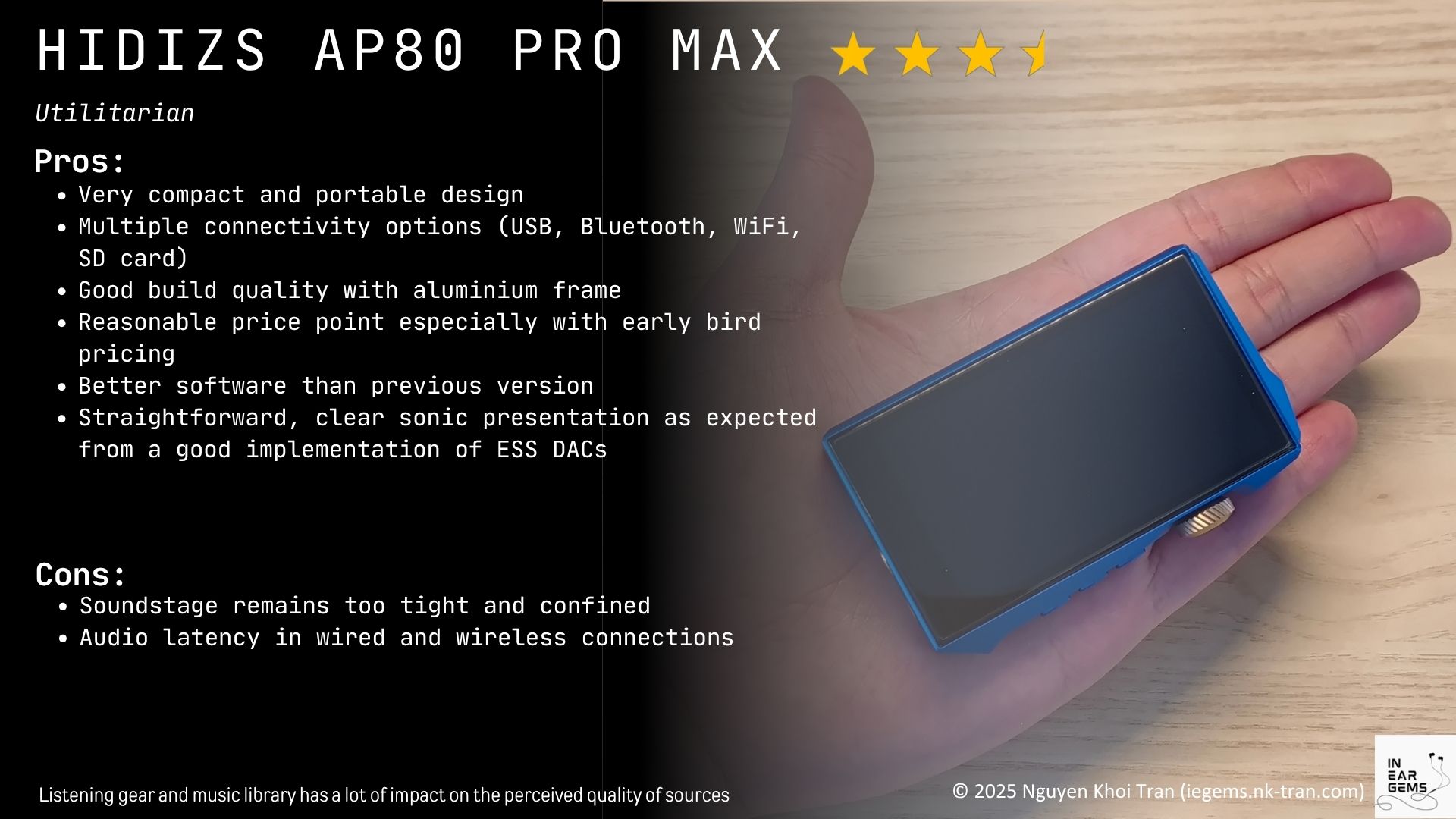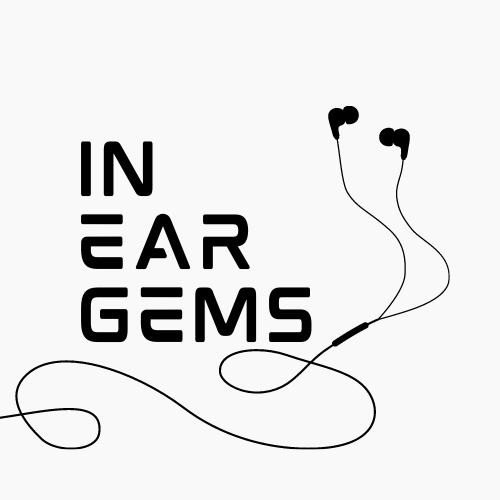AP80 Pro Max - Utilitarian
Today, we have a look at AP80 Pro Max, the result of a collaboration between Hidizs and Linsoul.
Preambles
- In this review, I use the term “source” to denote a DAC+amp combo for brevity and convenience.
- Sources do not make sounds. Therefore, when I say sources “sound” a certain way, I talk about the change they make to my IEMs and earphones.
- I want my music to be crisp, clear, well-separated and form a 3D soundstage around my head. Sources that intensify those characteristics of my IEMs are considered “better”.
- The unit used for this review was a sample provided by Hidizs (Thank you!). The unit is launching on kickstarter at early bird price of $149 Kickstarter (non-affiliated link).
General Information
The AP80 Pro Max is a micro DAP (Digital Audio Player) from Hidizs and the direct upgrade of the ever popular entry-level DAP AP80 Pro X. This device is part of a collaboration between Hidizs and Linsoul (yes, that Linsoul that makes and sells all sorts of personal audio gears)
Physical Design
AP80 Pro Max is a tiny device, even in micro DAP standard. It measures only 82.8 x 51 x 15.5mm. Online photos don’t fully convey how tiny it actually is. It’s shorter, narrower, and thinner than other micro DAPs currently on the market. The construction features an aluminium alloy frame construction with a geometric design. The front and back panels are made of glass.
The screen is a 2.95 inch display with 360x640 pixels resolution. There is a physical playback control button on the right side and a volume wheel with an ALPS potentiometer.
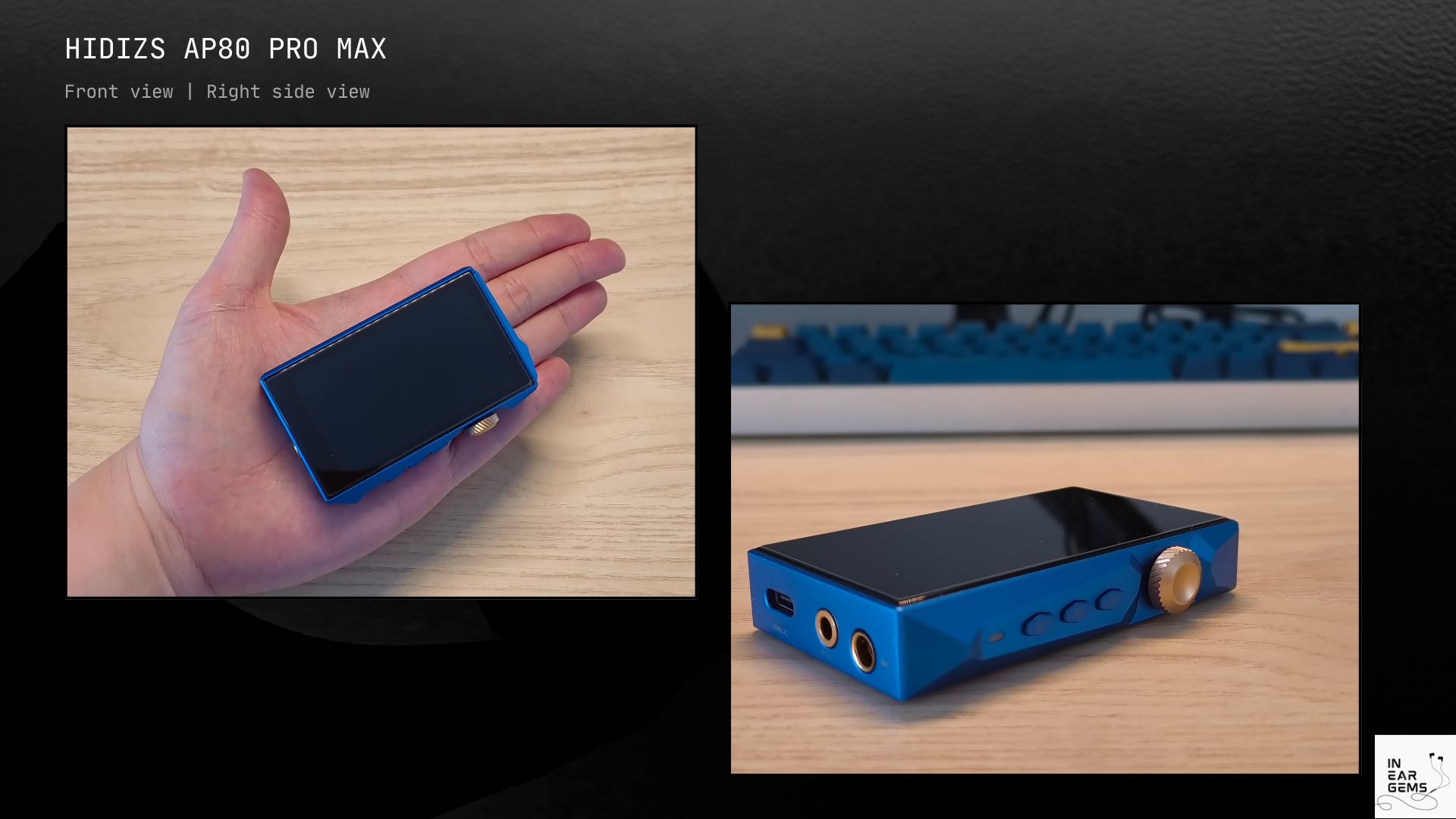
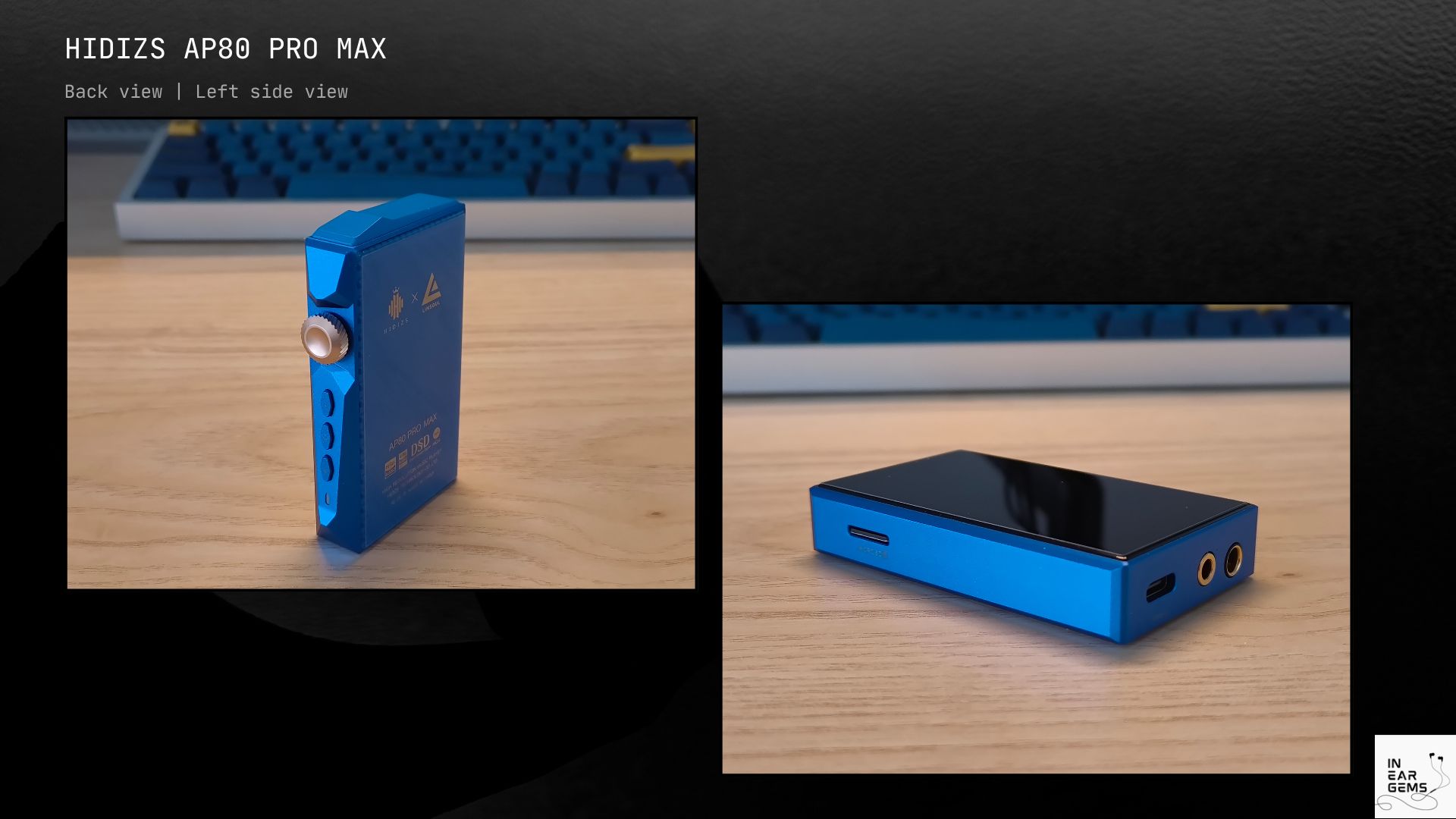
Internals and Connectivity
The AP80 Pro Max uses a X1600E System on Chip (SoC) to drive the software experience. It runs on HibyOS, a Linux-based operating system. The audio hardware features two ES9219C DAC chips, supporting DSD256 native decoding and PCM 384kHz/32bit audio with MQA 16x decoding.
Connectity wise, AP80 Pro Max has a 3.5mm single-ended output with 70 + 70mW @ 32Ω and a 4.4mm balanced output with 125 + 125mW @ 32Ω. The device also includes a microSD card slot that accepts up to 2TB cards and one USB-C port for charging, data input/output, Bluetooth 5.1 (bi-directional with LDAC and AptX codec support), and 2.4GHz WiFi.
The device is powered by a 1300mAh 3.8V battery, which theoretically provides 12 hours of playback and 60 days of standby time.
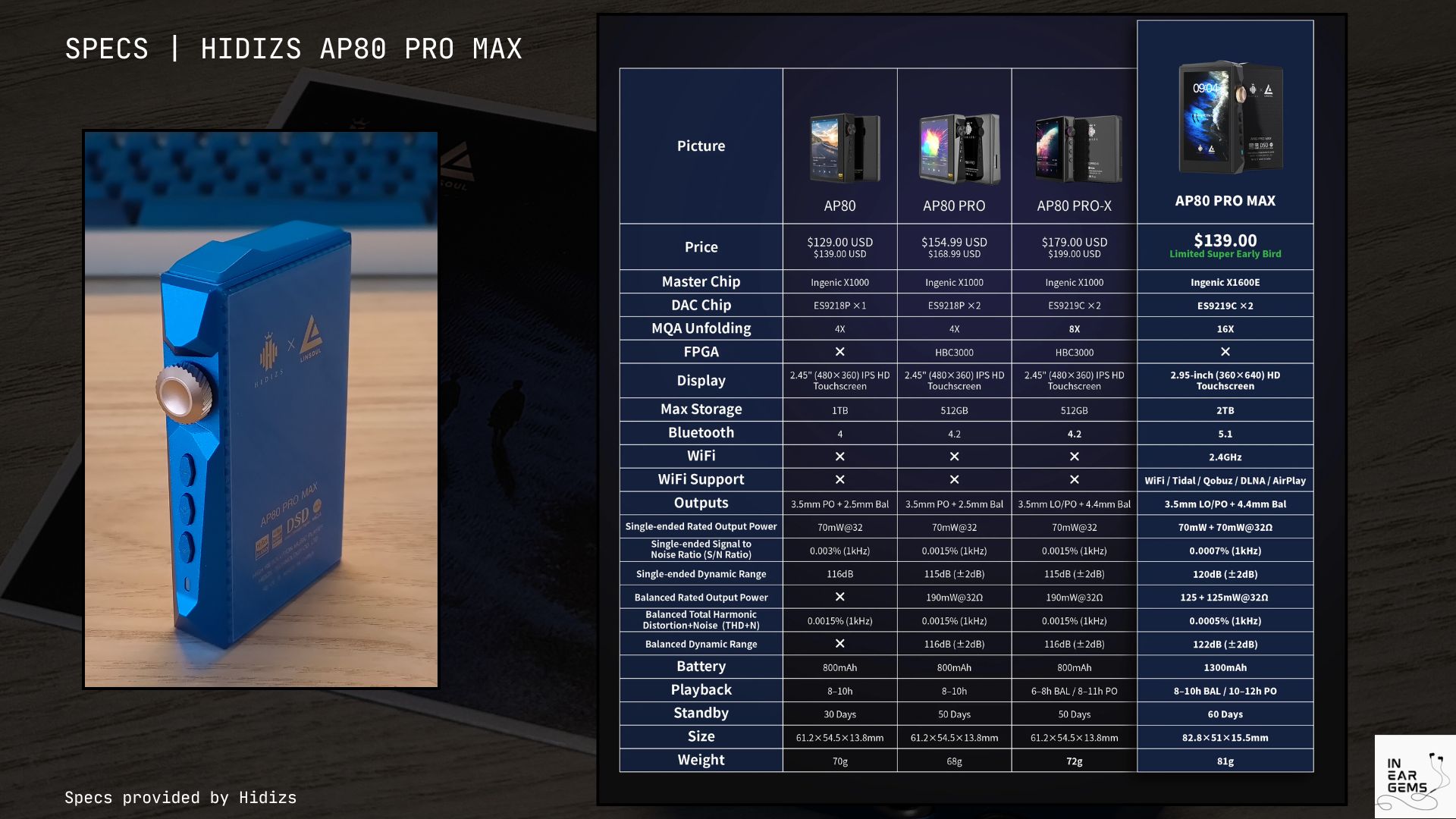
Packaging and Accessories
The packaging is a very compact cardboard box. Inside, there’s a greeting card co-signed by Hidizs and Linsoul. Under the card, you’ll find the DAP itself, which comes with a pre-applied screen protector. Included in the box are a USB-A to USB-C cable and a shorter USB-C to USB-C cable.
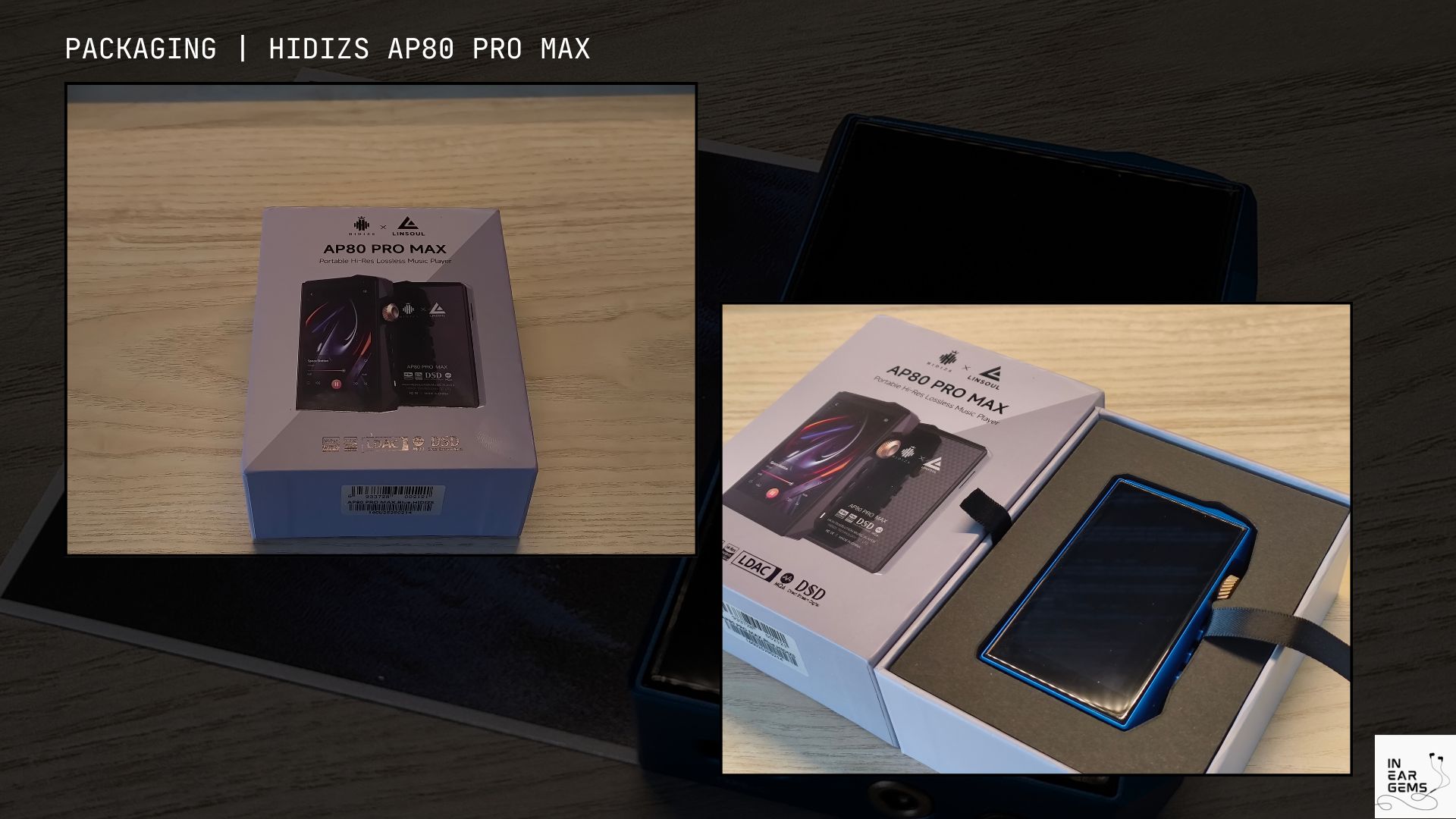
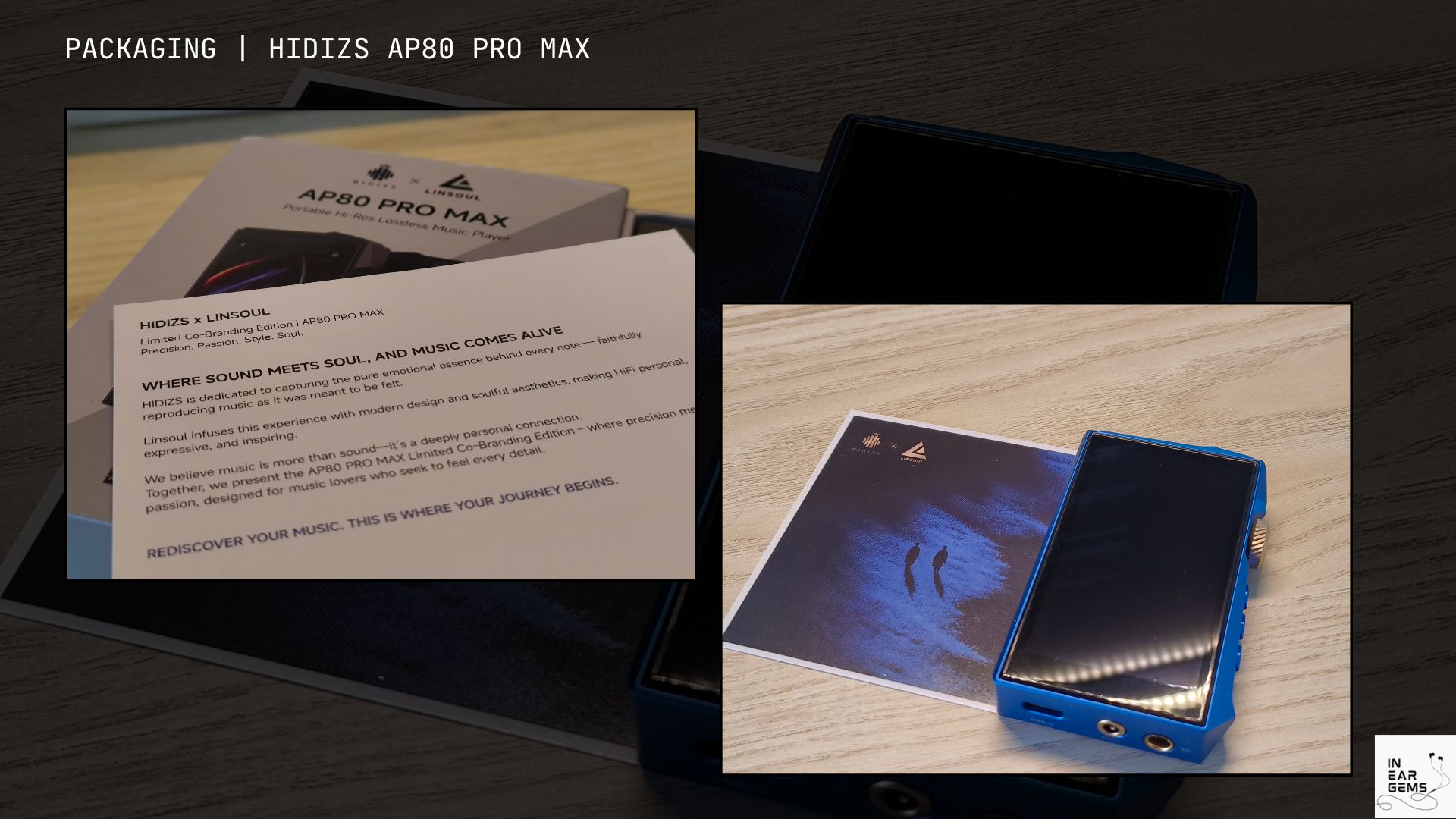
Features and Functionality
This DAP offers a wide range of features. It can play lossless music from local files on SD cards, provide digital output via USB to an external DAC, and act as an external USB DAC for phones or laptops. It can stream music directly from Tidal and Qobuz using onboard 2.4GHz WiFi.
The device also functions as a Bluetooth transmitter, sending Bluetooth audio from onboard lossless playback or WiFi streaming to wireless earbuds. It works as a Bluetooth receiver, receiving audio signals from phones or laptops via Bluetooth. Additionally, it can receive audio content from phones or computers via AirPlay and DLNA.
Software Experience
The AP80 Pro Max runs on HibyOS, a Linux-based operating system developed by Hiby. This is the same OS used in the older AP80 Pro X model, but the newer version installed on this device provides a somewhat different user interface experience.
The software interface operates through a touchscreen that responds to finger taps for selection and scrolling through menus. Users can swipe from the side of the screen to navigate back to previous screens, similar to modern phone operating systems. The interface is straightforward for basic tasks like browsing and playing local music or streaming content.
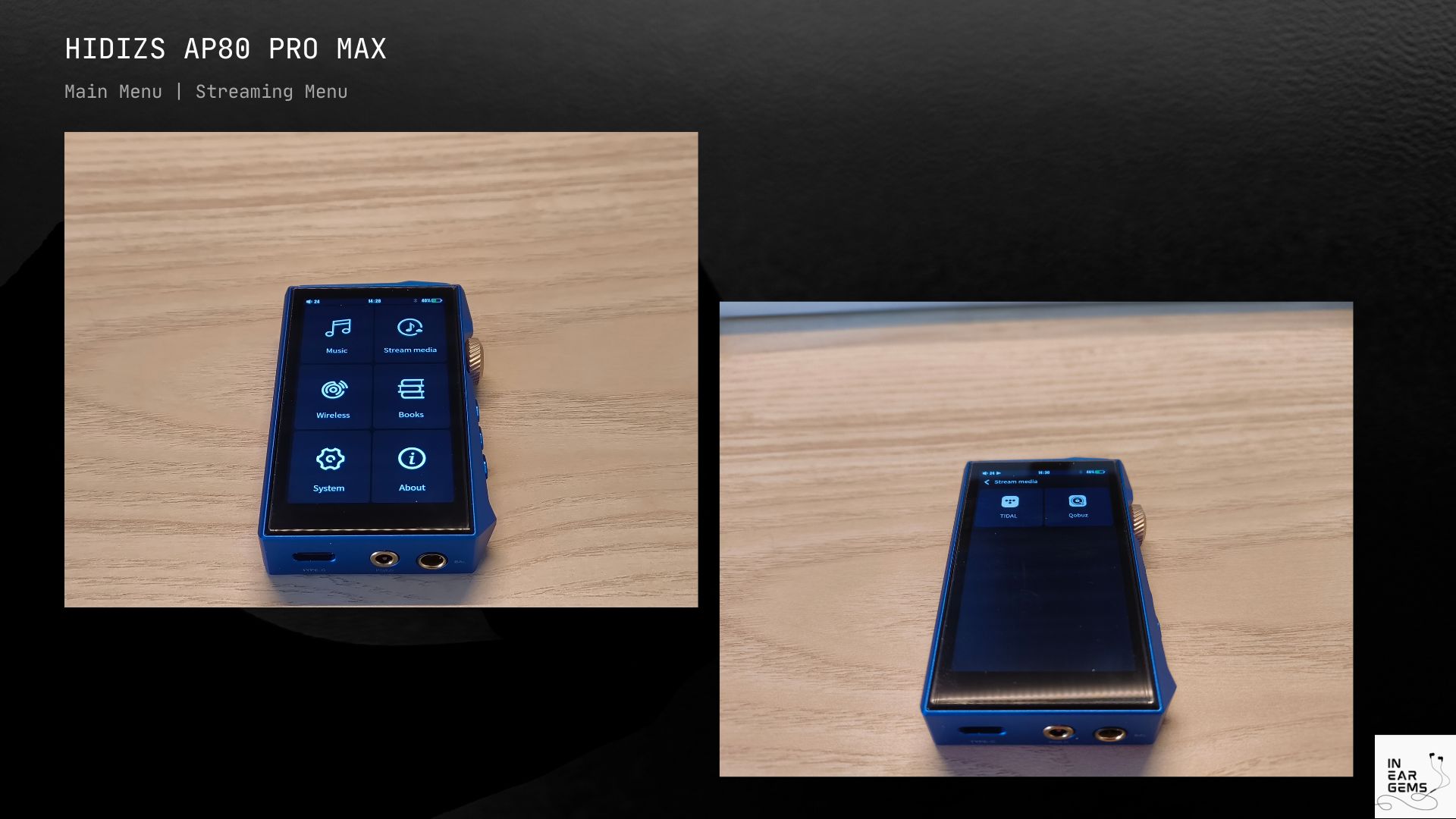
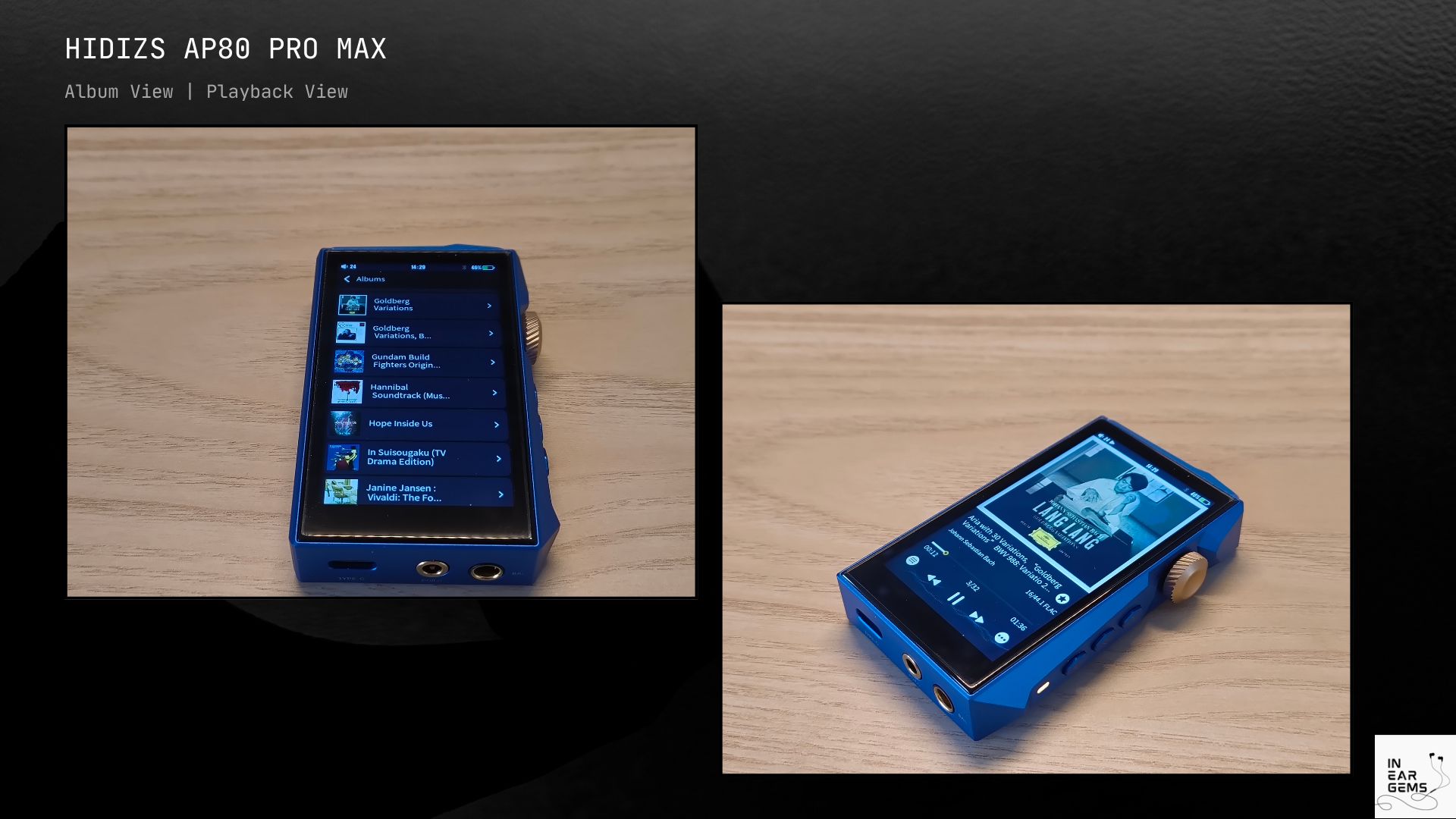
However, the software experience can be somewhat confusing when accessing certain settings. The sound-shaping tools including 10-band graphical EQ, parametric EQ (PEQ), and MSEB are quite hidden. Users must go to the music page and find a tiny gear icon at the top corner of the screen to access playback settings including EQ options. It’s quite tricky to hit this gear icon correctly when you put the DAP in a case.
When you finally managed to hit this icon you would have access to EQ options along with other playback related options. On my unit, I found 10-band graphical EQ and MSEB. Hidizs promises that a full parametric EQ would be available in production unit as well.
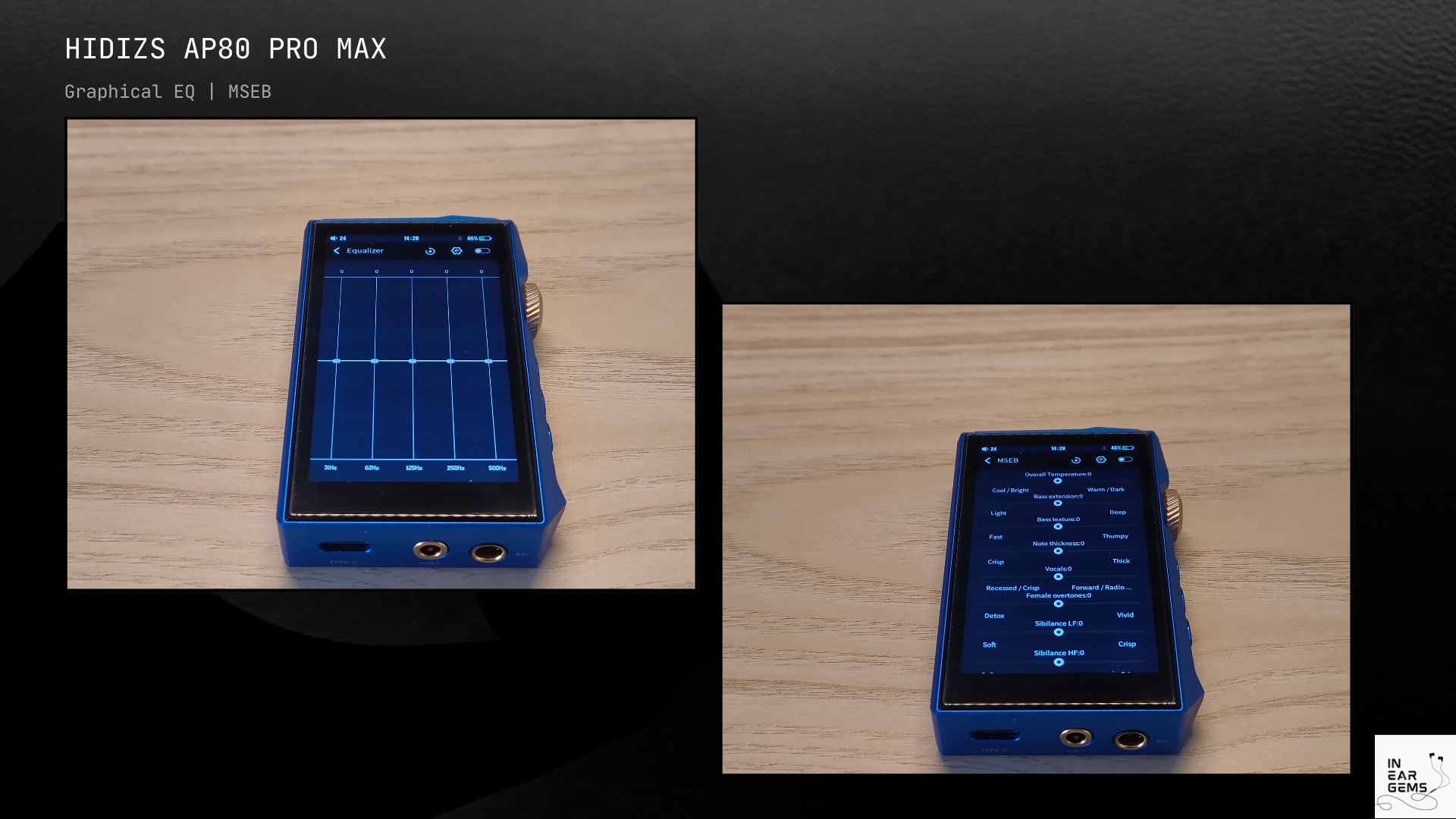
Beside local file playback, you can also stream from tidal and Qobuz using onboard 2.4 Ghz wifi. The streaming UI is simple as expected, but you can still access your library library and check new releases.
Bluetooth functionality shows some improvement over the previous AP80 Pro X model. When connecting to my phone, it automatically connects correctly to LDAC instead of incorrectly connecting to the inferior SBC codec. However, audio latency remains problematic with both wireless and wired connections. There is a noticeable delay between audio and video, impacting lip sync in videos. In orchestral recordings, I notice the orchestra lags behind the conductor.
Besides bluetooth, the device also supports receiving audio content from phones or computers via AirPlay and DLNA protocols.
Usage Experience
I’ve been using the AP80 Pro Max for nearly a month now. The build quality still feels solid. I still can’t get over the fact how small it is in real life. This small size makes it light, easy to carry, and fits comfortably in my pocket or bag.
The change from the 2.5mm connector of the older AP80 Pro X to the 4.4mm connector is a welcome improvement. Most of my cables already have 4.4mm jacks, so this transition makes using the device more convenient. The device’s size makes it easy to slip into a jacket pocket or small bag without taking up much space.
The screen is a 2.95 inch display with 360x640 pixels. While it serves its purpose, I find it slightly washed out and low contrast. I mostly turn it off after selecting a song, so this isn’t a major issue for me. The touchscreen interface works as expected, with the ability to navigate through menus and scroll by swiping.
One of the main reasons I’ve been using this device is for local music playback on commute. From a functionality perspective, the AP80 Pro Max handles this task as competently as you would expect. I’ve also used it as a USB DAC for my desktop PC at the office for background music. It’s been reliable for this use case, though I’ve noticed the USB connection does introduce some latency issues. The wireless features have proven useful as well. I use it as a Bluetooth receiver for my phone for watching YouTube at night. The Bluetooth receiver function works, though it doesn’t provide the best audio experience due to the latency. At least, I appreciate that it automatically connects to LDAC when connecting to my phone this time, which was an improvement over the previous model.
Battery performance seems to reflect Hidizs’ estimation, even though the battery indicator drops faster than I expected. For example, halfway through a Mendelssohn violin concerto in E minor, I already noticed a 2% drop in battery. However, subjectively the device can last multiple days with my use case, and when I turn it off, the device does not seem to lose any charge.
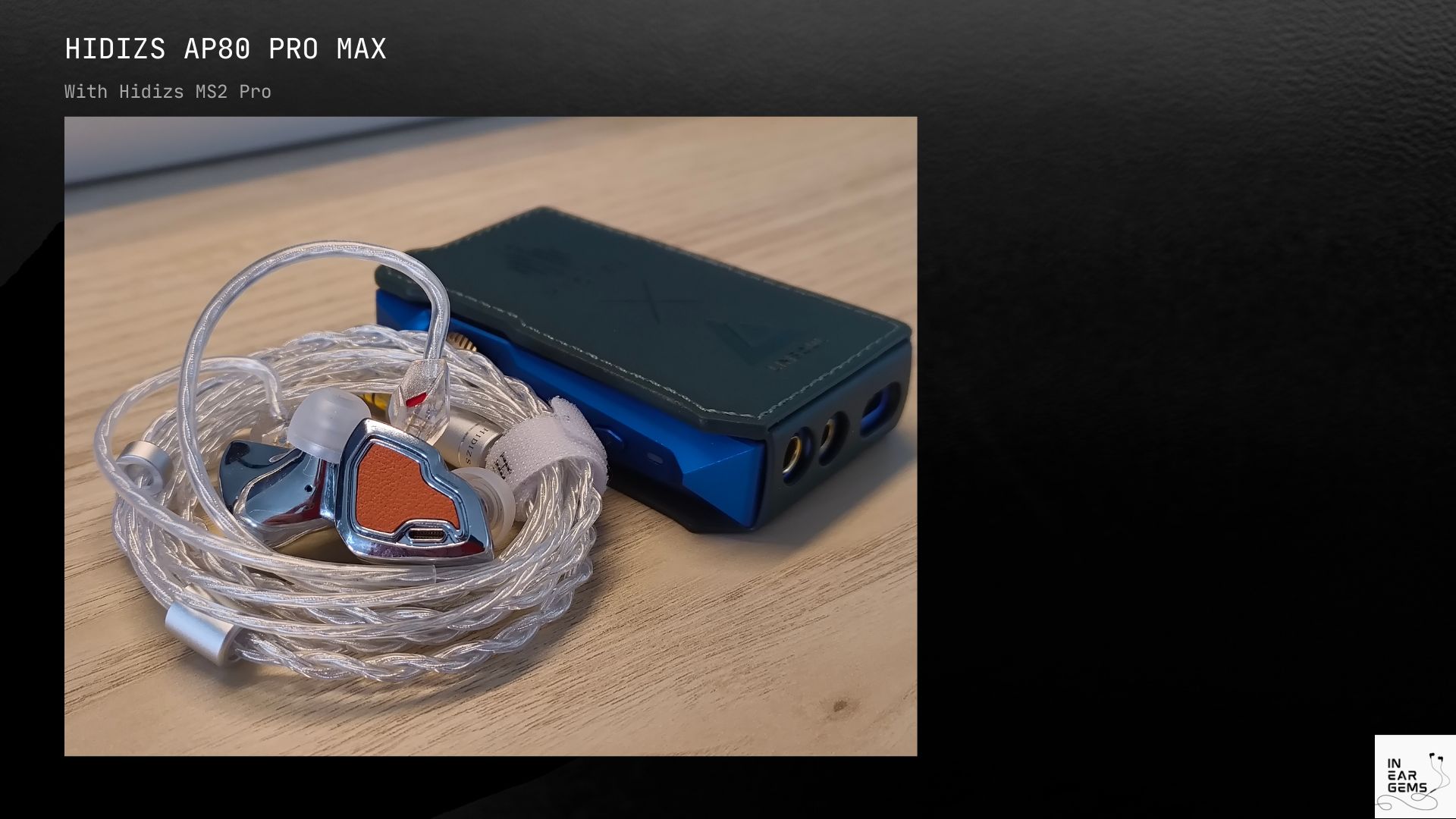
Sound Quality
I find the AP80 Pro Max’s sound to be quite clear and transparent, with a focus on accuracy rather than coloration. The audio output delivers a tight and precise presentation that reveals the details in recordings. However, this clarity comes with limitations in terms of spatial perception and dynamic expression.
Tonality
The tonality of this DAP presents a relatively neutral character. It’s not harsh or piercing, which is a positive aspect. The sound signature feels more midrange-centric compared to what I’ve heard from other devices recently, which tend to feel more “U-shaped” with perceived boost in the lower bass and upper treble.
Soundstage
What stands out most is how compact the soundstage feels. Elements in the mix cluster tightly around the fantom center in the middle of my head rather than spreading out across a wider spatial area. The sense of depth is limited, with the majority of audio elements appearing close to the phantom center of the listening space. Even when background elements such as distant instruments or ambience are present, they don’t create the sense of space that I would expect from a more open presentation.
This tight soundstage can be a limitation for orchestral or ambient recordings. The presentation feels more intimate rather than expansive, and I notice that the sense of scale and spatial relationships between different elements in the mix is diminished. While I can hear the individual components, they don’t create that wide sense of sonic space that allows recordings to feel more immersive.
Dynamic Performance
In terms of dynamic performance, the DAP handles musical passages adequately. The bass can punch when required, but it lacks that sense of power and resonance that would make it feel more impactful. The presentation is clean and tight, but it doesn’t convey that sense of musical energy and impact that would make the listening experience more engaging. The dynamics feel more subdued and restrained, which may work for some listening preferences but falls short of what I consider a truly dynamic presentation.
Resolution
The resolution is adequate. Not much more to say, really. It does not reveal more details than expected. At the same time, it does not feel mushy or blurry.
Selected Comparisons and Pairing
Comparison with Hidizs XO
The Hidizs XO can be considered the DAC version of the AP80 Pro Max, as both use the same ES9219C DAC chips. However, the actual sound differs significantly. The XO presents a larger sonic picture compared to the AP80 Pro Max. When listening to orchestral recordings, the soundstage on the XO feels more expansive, as if the action happens beyond the headstage. In contrast, the AP80 Pro Max keeps most of the action “inside the skull,” making the presentation feel more confined. I was surprised by how noticeable the difference is between these two devices on this aspect.
The tonality of the XO also differs from the AP80 Pro Max. The XO has a more “U-shaped” frequency response with a slightly recessed midrange and more emphasis on the treble. The AP80 Pro Max, on the other hand, focuses more on the midrange frequencies. Technical aspects like dynamics and resolution show minimal differences between the two.
Comparison with AP80 Pro X
As the upgraded version of the AP80 Pro X, the AP80 Pro Max offers improvements in all areas. Both devices share similar sound signatures, but the newer model delivers better overall performance. The AP80 Pro Max provides more detailed sound, better nuances and depth, and a slightly larger soundstage with improved perception of depth and layering.
Conclusions
Overall, I think the AP80 Pro Max is utilitarian.
It’s convenient, and it’s multi functional, though it’s not particularly inspiring, sonic wise. In this regard, it’s very similar to its predecessor, the AP80 Pro X. Fortunate for AP80 Pro Max, it does a better job than its predecessor, on all aspects, from software to sound quality.
I think the core value of the device lies in its portability and convenience, and lower price vs other micro DAPs in its class. It’s very small, so easy to bring with you. It provides various functionality to address your audio needs throughout the day. The price is low, as I mentioned, especially in at the early bird price. I find the design is also rather nice to look and feel.
Who this device is for? I think if you have set aside a budget of around $100 for a USB DAC, you can extend the budget a bit to get one of these DAPs to gain more functionality. Another type of user who benefits from AP80 Pro Max is someone who needs an audio source to play lossless FLAC file or receive bluetooth signal to output to an external DAC or amplifier.
What I like about this DAP:
- Very compact and portable design
- Multiple connectivity options (USB, Bluetooth, WiFi, SD card)
- Good build quality with aluminium frame
- Reasonable price point especially with early bird pricing
- Better software than previous version
- Straightforward, clear sonic presentation as expected from a good implementation of ESS DACs
What could be improved:
- Soundstage remains too tight and confined
- Audio latency in wired and wireless connections
